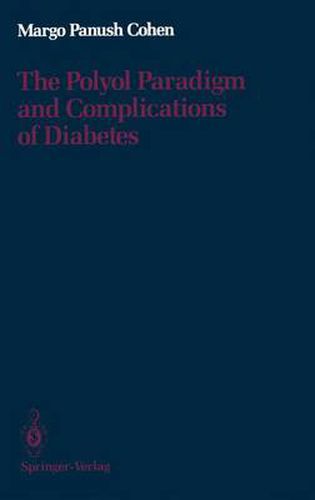Readings Newsletter
Become a Readings Member to make your shopping experience even easier.
Sign in or sign up for free!
You’re not far away from qualifying for FREE standard shipping within Australia
You’ve qualified for FREE standard shipping within Australia
The cart is loading…






This title is printed to order. This book may have been self-published. If so, we cannot guarantee the quality of the content. In the main most books will have gone through the editing process however some may not. We therefore suggest that you be aware of this before ordering this book. If in doubt check either the author or publisher’s details as we are unable to accept any returns unless they are faulty. Please contact us if you have any questions.
In the last decade, it has become increasingly evident that the clini- cal and morphologic changes underlying many of the complications of diabetes, including cataract formation, retinopathy, nephropathy, neuropathy, and macrovascular disease, are preceded by a variety of disturbances of biochemical and physiologic origin. Dr. Cohen has recently written a superb monograph, entitled Diabetes and Protein Glycosylation: Measurement and Biologic Relevance, in which she thoroughly explores how enhanced nonenzymatic glycosylation in uncontrolled diabetes underscores the pressing need for main- tenance of long-term euglycemia. In the present volume, The Polyol Paradigm and Complications of Diabetes, she reviews, in a most succinct and thorough manner, how another biochemical mechan- ism, involving the polyol pathway, is involved in the pathogenesis of such diabetes complications as retinopathy, neuropathy, nephropa- thy, and cataract formation. Dr. Cohen gives us a clearly written and comprehensive mono- graph, reviewing the chemistry of the polyol pathway and of the aldose reductase inhibitors, and the pathophysiologic significance of increased polyol pathway activity in a variety of tissues affected by Vlll Foreword diabetes mellitus. She insightfully describes the relationship of increased polyol pathway activity to altered metabolism of inositol- containing phospholipids and to changes in various tissue concentra- tions of myo-inositol. Finally, she provides us with a careful review of the existing experimental and clinical studies with a variety of different aldose reductase inhibitors that have been and are being performed in the hope of preventing or reversing long-term compli- cations of diabetes.
$9.00 standard shipping within Australia
FREE standard shipping within Australia for orders over $100.00
Express & International shipping calculated at checkout
This title is printed to order. This book may have been self-published. If so, we cannot guarantee the quality of the content. In the main most books will have gone through the editing process however some may not. We therefore suggest that you be aware of this before ordering this book. If in doubt check either the author or publisher’s details as we are unable to accept any returns unless they are faulty. Please contact us if you have any questions.
In the last decade, it has become increasingly evident that the clini- cal and morphologic changes underlying many of the complications of diabetes, including cataract formation, retinopathy, nephropathy, neuropathy, and macrovascular disease, are preceded by a variety of disturbances of biochemical and physiologic origin. Dr. Cohen has recently written a superb monograph, entitled Diabetes and Protein Glycosylation: Measurement and Biologic Relevance, in which she thoroughly explores how enhanced nonenzymatic glycosylation in uncontrolled diabetes underscores the pressing need for main- tenance of long-term euglycemia. In the present volume, The Polyol Paradigm and Complications of Diabetes, she reviews, in a most succinct and thorough manner, how another biochemical mechan- ism, involving the polyol pathway, is involved in the pathogenesis of such diabetes complications as retinopathy, neuropathy, nephropa- thy, and cataract formation. Dr. Cohen gives us a clearly written and comprehensive mono- graph, reviewing the chemistry of the polyol pathway and of the aldose reductase inhibitors, and the pathophysiologic significance of increased polyol pathway activity in a variety of tissues affected by Vlll Foreword diabetes mellitus. She insightfully describes the relationship of increased polyol pathway activity to altered metabolism of inositol- containing phospholipids and to changes in various tissue concentra- tions of myo-inositol. Finally, she provides us with a careful review of the existing experimental and clinical studies with a variety of different aldose reductase inhibitors that have been and are being performed in the hope of preventing or reversing long-term compli- cations of diabetes.